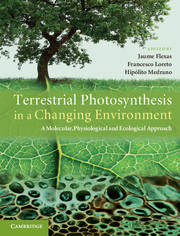 Terrestrial Photosynthesis in a Changing Environment
Terrestrial Photosynthesis in a Changing Environment Book contents
- Frontmatter
- Contents
- List of contributors
- Preface
- Acknowledgements
- List of abbreviations
- 1 Terrestrial photosynthesis in a changing environment
- Part I Photosynthesis
- Part II Measuring photosynthesis
- 9 Gas-exchange analysis: basics and problems
- 10 Optical methods for investigation of leaf photosynthesis
- 11 Stable isotopic compositions related to photosynthesis, photorespiration and respiration
- 12 Mesophyll conductance to CO2
- 13 Biochemical and molecular techniques for the study of photosynthetic processes
- 14 Measuring CO2 exchange at canopy scale: the eddy covariance technique
- 15 Remote sensing of photosynthesis
- Part III Photosynthetic response to single environmental factors
- Part IV Photosynthesis in time
- Part V Photosynthesis in space
- Part VI Photosynthesis in a global context
- References
- Index
11 - Stable isotopic compositions related to photosynthesis, photorespiration and respiration
Published online by Cambridge University Press: 05 March 2013
- Frontmatter
- Contents
- List of contributors
- Preface
- Acknowledgements
- List of abbreviations
- 1 Terrestrial photosynthesis in a changing environment
- Part I Photosynthesis
- Part II Measuring photosynthesis
- 9 Gas-exchange analysis: basics and problems
- 10 Optical methods for investigation of leaf photosynthesis
- 11 Stable isotopic compositions related to photosynthesis, photorespiration and respiration
- 12 Mesophyll conductance to CO2
- 13 Biochemical and molecular techniques for the study of photosynthetic processes
- 14 Measuring CO2 exchange at canopy scale: the eddy covariance technique
- 15 Remote sensing of photosynthesis
- Part III Photosynthetic response to single environmental factors
- Part IV Photosynthesis in time
- Part V Photosynthesis in space
- Part VI Photosynthesis in a global context
- References
- Index
Summary
Historical Overview of Stable Isotopic Studies in Plant Science
Isotopes are atoms of the same element having the same numbers of protons and electrons but a different number of neutrons. Stable isotopes are those that do not decay to other isotopes on the geological timescales, but can themselves be originated from the decay of radioactive isotopes.
The stable isotopes of carbon and oxygen have major relevance for photosynthesis, respiration and photorespiration, and link the carbon and water cycles. Hence, this chapter will attempt to summarise the current knowledge of processes affecting the stable carbon and oxygen isotopic composition of plants and the exchange between plants (and ecosystems) and the atmosphere.
In addition, hydrogen, nitrogen and sulphur isotopes also have major relevance for plant biology and physiological ecology, but these will not be covered here as these subjects are out of the scope of this book.
Early studies and measurements of stable isotopes in plants were initiated by scientists outside biology, with the initial interest developed in physical science and subsequently extended to geology. Studies were focused on deuterium and its variation in nature, as it was the first isotope to be discovered and was the easiest to measure with the equipment then available, mainly spectrographs. It was not until the late 1930s/early 1940s, with the development of a modern sector i eld-isotope mass spectrometer by Alfred Nier ( 1940 ), that precise measurements of other isotopes such as carbon and oxygen became possible.
- Type
- Chapter
- Information
- Terrestrial Photosynthesis in a Changing EnvironmentA Molecular, Physiological, and Ecological Approach, pp. 152 - 168Publisher: Cambridge University PressPrint publication year: 2012
